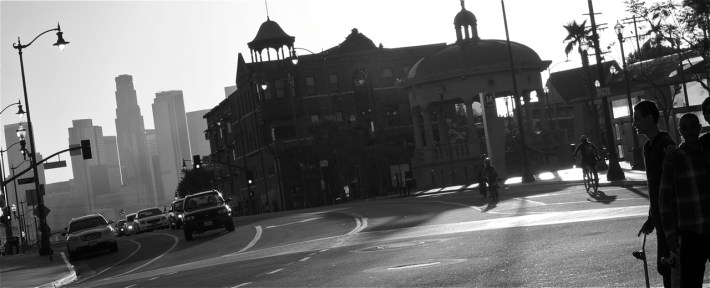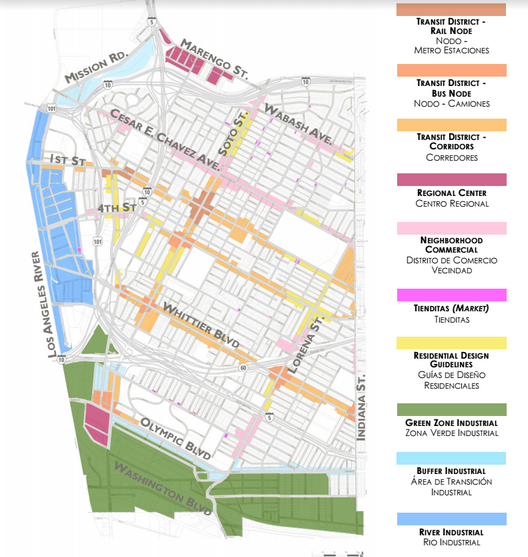
Tuesday night, from 6 - 8:30 p.m., the Department of City Planning will be holding a Scoping Meeting to gather feedback from the community regarding the potential impacts the policies and goals contained within Boyle Heights Community Plan might have on the area's environment, as required by the California Environmental Quality Act (CEQA).
The meeting will not be, as I am guessing some in the community might be hoping, a genuine opportunity to directly address gentrification concerns. The Environmental Impact Report planners will be drafting focuses on categories that focus on the impact of physical infrastructure on things like aesthetics, air quality, noise, transportation/circulation, and greenhouse gas emissions (see full list here, p. 3). To the extent that it can address population/housing/employment or cultural resources questions, it is more in terms of whether a policy or program will have a direct impact on an existing entity (e.g. direct displacement of people or cultural structures to make way for something new).
Which means that if you do have concerns about the kinds of changes slated for the community, you will have to approach them through some of the goals and policies planners are drafting to guide development.
The Boyle Heights Community Plan (BHCP) has been in the works for ten years now. It is one of 35 Community Plans contained within the Land Use Element of the City's General Plan. And it is intended to serve as a blueprint for growth and development in the area by delineating goals, policies, and specific development standards for the residential, commercial, and industrial zones within the community for the next 20 to 25 years. It was last updated in 1998 and was intended to govern growth and change in Boyle Heights through 2010.
Outreach efforts begun back in 2006 worked to nail down the community's larger vision and goals for the area that planners would then try to build into the policies established for the plan. The planning process unfortunately had to be put on hold in 2009, and was not picked up again until 2012.
At an open house in 2014, planners presented attending community members with the following draft vision statement:
This community is built on generations of immigrants and prides itself in their hard work ethic, rich cultural identities, and community activism. Boyle Heights is a historical and cultural treasure with a diverse local economy that has a potential to continue prospering. Building upon its pedestrian-oriented and unique neighborhood character, this community envisions policy programs that are supportive of environmental quality, economic vitality, and urban design that promotes safe and walkable neighborhoods.
The community's responses to the above statement and a variety of themes including affordable housing, employment, preserving and enhancing the social, artistic, cultural, and historic characteristics of the community, and, interestingly, strengthening the community's connection to the L.A. River, among many other things (see the full list here) were supposed to give planners a better sense of how to formulate their goals and policies.
One only need take a look at the input received on a variety of land-use topics at prior sessions to see that

that was likely not always an easy task. Parking seemed to be one of the few things that united everyone - all could agree there was not enough of it. Otherwise, clear divides seemed to run between renters and homeowners: Bring in businesses like Target and Trader Joe's! Don't allow big box stores that will displace local businesses! Tienditas (small corner markets often embedded within residential areas) are a great resource and could, with aid, be able to provide locals with access to healthier food! Tienditas are the devil and a gateway to substance abuse! Build more housing! Preserve neighborhood character and height! (see the full list here and feedback from focus groups over the years, here.)
The policies and protections many in the community would like to see put in place to limit the dismantling and displacement of the human infrastructure that makes the community so unique don't fit easily into a planning framework designed to address questions of physical infrastructure.
Policies could, for example, require that commercial districts reflect a particular architectural history and support street vending, as explained here. But there are fewer safeguards available to support the existing businesses occupying those locations or ensure that it is the long-time paletero who is ultimately able to vend there, not Paleta People.
Which doesn't mean that planners are not aware of some of these issues. Indeed, in their draft goals (found here), they speak to the importance of affordable, multi-generational, family-oriented housing, ask developers to build relationships with the community from the outset, support mobility for seniors and the disabled, speak of the importance of connectivity to jobs, support the preservation of murals, and acknowledge the importance of the cultural heritage of the area.
But the goals also speak to areas where there might be some friction with the community, too, particularly the favoring of development around Gold Line stations rather than bus corridors (Boyle Heights residents are much more reliant on the bus system; rail is more likely to be a draw for higher-income folks from outside the community), the creation of an arts district or business improvement district (some feel that could speed gentrification), and the adaptive reuse of industrial buildings along the river for "artisanal and creative industries" (raising more concerns about gentrification). See the full set of draft goals, here.

At tomorrow night's meeting, planners will be looking for community feedback on some of the proposed zone changes and the extent to which attendees think those proposed changes will help preserve the community's structures and character, encourage growth appropriately, and create a healthier environmental landscape in the process.
The meeting will be held at Boyle Heights City Hall, 2130 1st Street, from 6 - 8:30 p.m. The notice of preparation regarding the scoping meeting can be found here. Details and documents related to the BHCP can be found here. And City Planning has put together a handy little video to introduce you to the scoping process (below). The deadline for commenting on the project is October 7.






